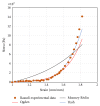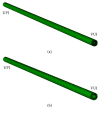Fluid Structural Analysis of Urine Flow in a Stented Ureter
- PMID: 27127535
- PMCID: PMC4830759
- DOI: 10.1155/2016/5710798
Fluid Structural Analysis of Urine Flow in a Stented Ureter
Abstract
Many urologists are currently studying new designs of ureteral stents to improve the quality of their operations and the subsequent recovery of the patient. In order to help during this design process, many computational models have been developed to simulate the behaviour of different biological tissues and provide a realistic computational environment to evaluate the stents. However, due to the high complexity of the involved tissues, they usually introduce simplifications to make these models less computationally demanding. In this study, the interaction between urine flow and a double-J stented ureter with a simplified geometry has been analysed. The Fluid-Structure Interaction (FSI) of urine and the ureteral wall was studied using three models for the solid domain: Mooney-Rivlin, Yeoh, and Ogden. The ureter was assumed to be quasi-incompressible and isotropic. Data obtained in previous studies from ex vivo and in vivo mechanical characterization of different ureters were used to fit the mentioned models. The results show that the interaction between the stented ureter and urine is negligible. Therefore, we can conclude that this type of models does not need to include the FSI and could be solved quite accurately assuming that the ureter is a rigid body and, thus, using the more simple Computational Fluid Dynamics (CFD) approach.
Figures
Similar articles
-
Numerical analysis of the urine flow in a stented ureter with no peristalsis.Biomed Mater Eng. 2015;26 Suppl 1:S215-23. doi: 10.3233/BME-151308. Biomed Mater Eng. 2015. PMID: 26405994
-
Flow dynamics in a stented ureter.Math Med Biol. 2009 Mar;26(1):1-24. doi: 10.1093/imammb/dqn020. Epub 2008 Nov 5. Math Med Biol. 2009. PMID: 18990681
-
A mathematical simulation of the ureter: effects of the model parameters on ureteral pressure/flow relations.J Biomech Eng. 2011 Mar;133(3):031004. doi: 10.1115/1.4003316. J Biomech Eng. 2011. PMID: 21303180
-
Simulation of the upper urinary system.Crit Rev Biomed Eng. 2013;41(3):259-68. doi: 10.1615/critrevbiomedeng.2013009704. Crit Rev Biomed Eng. 2013. PMID: 24579647 Review.
-
Ureteric injuries. Clinical and experimental studies.Scand J Urol Nephrol Suppl. 1995;171:1-66. Scand J Urol Nephrol Suppl. 1995. PMID: 8578244 Review.
Cited by
-
Urinary Stent Development and Evaluation Models: In Vitro, Ex Vivo and In Vivo-A European Network of Multidisciplinary Research to Improve Urinary Stents (ENIUS) Initiative.Polymers (Basel). 2022 Apr 19;14(9):1641. doi: 10.3390/polym14091641. Polymers (Basel). 2022. PMID: 35566810 Free PMC article. Review.
-
The interplay between bacterial biofilms, encrustation, and wall shear stress in ureteral stents: a review across scales.Front Urol. 2024 Jan 16;3:1335414. doi: 10.3389/fruro.2023.1335414. eCollection 2023. Front Urol. 2024. PMID: 40778079 Free PMC article. Review.
-
Electrospinning: Application and Prospects for Urologic Tissue Engineering.Front Bioeng Biotechnol. 2020 Oct 7;8:579925. doi: 10.3389/fbioe.2020.579925. eCollection 2020. Front Bioeng Biotechnol. 2020. PMID: 33117785 Free PMC article. Review.
-
Computational simulation of the flow dynamic field in a porous ureteric stent.Med Biol Eng Comput. 2022 Aug;60(8):2373-2387. doi: 10.1007/s11517-022-02620-1. Epub 2022 Jun 28. Med Biol Eng Comput. 2022. PMID: 35763188 Free PMC article.
-
Investigating the encrustation of reinforced ureteral stents by computational flow dynamic simulations.World J Urol. 2023 May;41(5):1451-1457. doi: 10.1007/s00345-023-04356-5. Epub 2023 Mar 17. World J Urol. 2023. PMID: 36930252 Free PMC article.
References
Publication types
MeSH terms
LinkOut - more resources
Full Text Sources
Other Literature Sources
Miscellaneous






